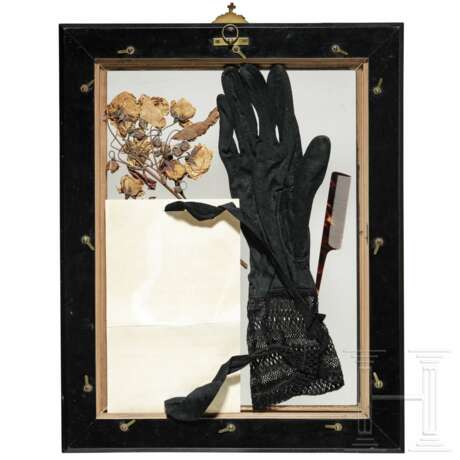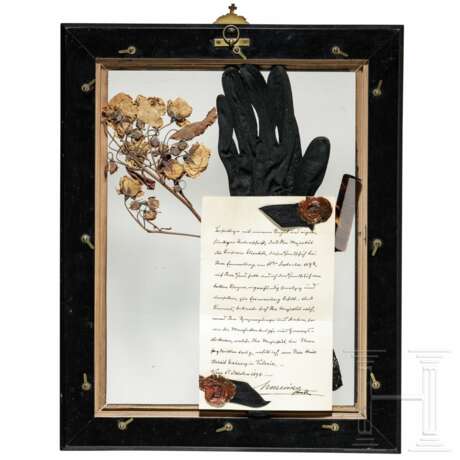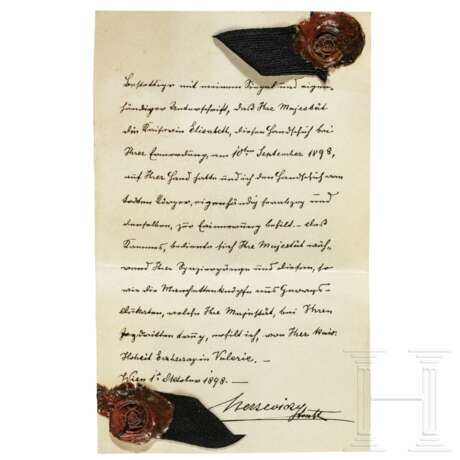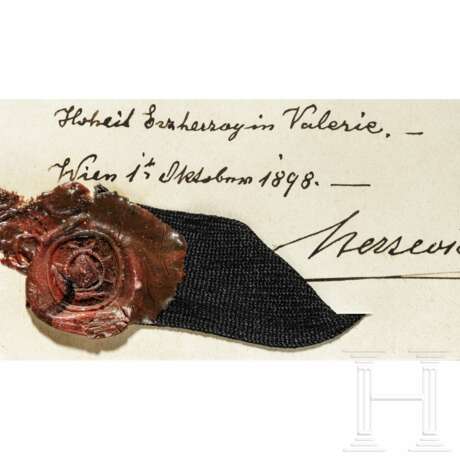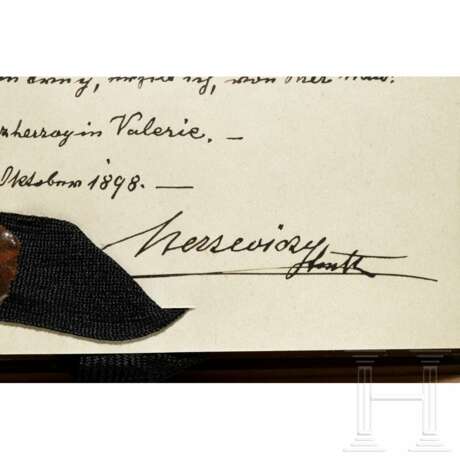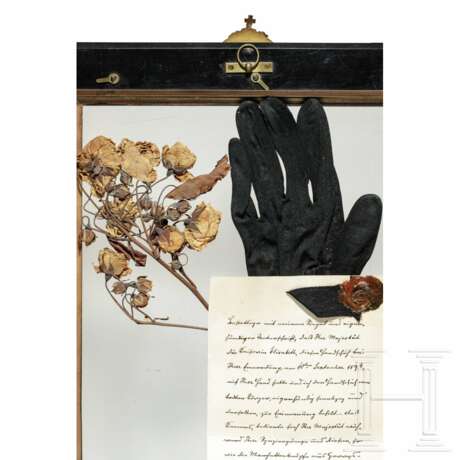Kaiserin Elisabeth von Österreich - schwarzer Seidenhandschuh der rechten Hand mit geklöppelter Stulpe, getragen am Tag ihrer Ermordung am 10. September 1898 in Genf
25.11.2021 10:00UTC +01:00
Classic
Vendu
66000EUR € 66 000
| Auctioneer | Hermann Historica |
|---|---|
| Lieu de l'événement | Allemagne, Grasbrunn / München |
| Commission | 25 % |
Archive
La vente aux enchères est terminée. Vous ne pouvez plus enchérir.

ID 663603
Lot 3138 | Kaiserin Elisabeth von Österreich - schwarzer Seidenhandschuh der rechten Hand mit geklöppelter Stulpe, getragen am Tag ihrer Ermordung am 10. September 1898 in Genf
Valeur estimée
€ 12 000
Schwarzer Seidenhandschuh mit drei Verstärkungskordeln am Handrücken. Ca. 8 cm lange Stulpe aus schwarzer Spitze. Die zwei Verschnürbänder an den Enden mit rotem Wachs an den Brief des Kammerherrn der Kaiserin, Graf von Berzeviczy, gesiegelt, in dem dieser eigenhändig und in Tinte schreibt: "Bestätige mit meinem Siegel und eigenhändiger Unterschrift, daß Ihre Majestät die Kaiserin Elisabeth, diesen Handschuh bei Ihrer Ermordung, am 10ten September 1898, auf Ihrer Hand hatte und ich den Handschuh vom todten [sic!] Körper, eigenhändig herabzog und denselben, zur Erinnerung behielt. – Deß Kammes, bediente sich Ihre Majestät während Ihrer Spaziergänge und diesen, so wie die Manschettenknöpfe (?)dukaten, welche Ihre Majestät, bei Ihren Jagdritten trug, erhielt ich, von Ihrer Kais. Hoheit Erzherzogin Valerie. Wien 1t Oktober 1898 - Berzeviczy", mit unleserlichem Titel-/Rangzusatz. Der Handschuh und Brief sowie der im Brief erwähnte Kamm und ein Sträußchen getrockneter Blumen gemeinsam unter Glas und in schlichtem, geschwärztem Holzrahmen mit aufgelegter vergoldeter Kaiserkrone. Länge des Handschuhs ca. 28,5 cm. Maße des Rahmens 35 (mit Krone 37) x 28,5 cm. Von historisch allergrößter Bedeutung.
General Albert Graf Berzeviczy von Berzevicze (1853 - 1936), Kämmerer Ihrer Majestät der Kaiserin, stellv. Obersthofmeister und laut der Hofdame der Kaiserin, der Gräfin Irma Sztáray ("Aus den letzten Jahren der Kaiserin Elisabeth", S. 106), "ein ganzer Mann und Soldat und bis ins Mark hinein ein wahrhafter, ehrlicher Charakter [...]. Die Kaiserin war ihm geneigt und vertraute ihm unbedingt. Sie nahm es ihm nie übel, wenn er gelegentlich seiner widersprechenden Meinung ihr gegenüber Ausdruck gab.". Graf Berzeviczy hatte sich die größten Sorgen insbesondere um den Genf-Aufenthalt der Kaiserin gemacht und warnte sie mehrfach davor, worauf die Kaiserin der Gräfin Sztáray erwiderte: "Sagen Sie Berzeviczy, seine Besorgnisse seien einfach lächerlich. Was könnte mir Genf schaden?" (S. 206). Am Tag ihrer Ermordung weilte Graf Berzeviczy in Territet, der nächsten Reisestation der Kaiserin, und kehrte noch am 10. September mit dem Abendzug nach Genf zurück. Um 10 Uhr abends betteten die Gräfin Sztáray, Graf Berzeviczy und der österreichische Gesandte in Bern, Graf Kuefstein, den Leichnam der Kaiserin in einen provisorischen Sarg um und hielten Totenwache. Als am Folgetag gegen 14 Uhr die Genehmigung für eine partielle Obduktion der Kaiserin aus Wien eintraf, nahmen diese drei sowie zwei Ärzte und ein Generalstaatsanwalt daran teil.
Provenienz: Fürst Albert von Thurn und Taxis (1867 - 1952), achter Fürst von Thurn und Taxis, Neffe der Kaiserin Elisabeth von Österreich (Sohn der älteren Schwester Helene in Bayern, 1834 - 1890) und seiner Gemahlin Erzherzogin Margarethe Klementine von Österreich. Wann und zu welchem Anlass der Handschuh sowie der ihm von Erzherzogin Marie Valerie geschenkte Kamm vom Grafen von Berzeviczy dem Fürstenpaar übergeben wurde, lässt sich leider nicht mehr feststellen. Die Erinnerungsstücke an Kaiserin Elisabeth wurden in dieser gerahmten Form mit dem Tod des Fürsten Albert von Thurn und Taxis 1952 an den neunten Fürsten von Thurn und Taxis, Franz Josef, vermacht und verblieben bis heute in Familienbesitz. Eine entsprechende Provenienz-Bestätigung der Familie liegt vor.
Zustand: II +
Empress Elisabeth of Austria – a right-hand glove in black silk with a lace cuff, worn on the day of her assassination in Geneva on September 10, 1898
The black silk glove with three reinforcing cords on the back of the hand. The cuff made of black lace, approx. 8 cm in length. The ends of the two lacing ribbons sealed in red wax onto the letter handwritten in ink by Count von Berzeviczy, chamberlain to the Empress, in which he declares (tr.): "I hereby confirm with my seal and my signature in my own hand that Her Majesty the Empress Elisabeth was wearing this very glove on her hand when she was assassinated on the 10th day of September 1898 and that I personally removed the glove from her dead body and kept it in remembrance. – That the comb was employed by Her Majesty when promenading and the cuff links (?)ducats were worn by Her Majesty when hunting, both of which I received from Her Imperial Highness Archduchess Valerie. Vienna, 1st day of October 1898 - Berzeviczy", along with an illegible title or rank. The glove and letter, together with the comb mentioned in the letter, and a posy of dried flowers all behind glass and in an unadorned, blackened wooden frame, appliquéd with a gilt imperial crown. Length of the glove approx. 28.5 cm. Dimensions of the frame 35 (including the crown 37) x 28.5 cm. Of the greatest historical significance.
General Albert Graf Berzeviczy von Berzevicze (1853 - 1936), chamberlain to Her Majesty the Empress, deputy steward of the imperial court and, according to the Empress' lady-in-waiting, Countess Irma Sztáray ("Aus den letzten Jahren der Kaiserin Elisabeth", p. 106), (tr.) "a man and soldier through and through, and a true, honest character to his very core [...]. The Empress was well-disposed towards him and trusted him implicitly. She never took offence if, on occasion, he expressed an opinion that conflicted with hers.". Count Berzeviczy had been extremely concerned, particularly at the Empress' plans to stay in Geneva and had warned her several times. Thereupon the Empress said to Countess Sztáray (tr.): "Tell Berzeviczy that his misgivings are simply preposterous. What harm could possibly come to me in Geneva?" (p. 206). On the day of her assassination, Count Berzeviczy was in Territet, the next leg of the Empress' journey, and returned to Geneva with the evening train on 10 September. At 10 pm that evening, Countess Sztáray, Count Berzeviczy and the Austrian ambassador in Bern, Count Kuefstein, placed the body of the Empress in a temporary coffin and held a vigil. When the approval for a partial autopsy of the Empress was received from Vienna around 2 pm the following day, it was attended by these three persons, two doctors and a public prosecutor.
Provenance: Albert, Prince of Thurn and Taxis (1867 - 1952), the eighth prince of Thurn und Taxis, nephew of Empress Elisabeth of Austria (the son of her older sister Helene in Bavaria, 1834 - 1890) and his wife Archduchess Margarethe Klementine of Austria. Unfortunately, it is not possible to establish when and on what occasion Count von Berzeviczy passed the glove and the comb given to him by Archduchess Marie Valerie onto the royal couple. On the death of Albert Prince of Thurn and Taxis in 1952, the mementos of Empress Elisabeth were bequeathed in this framed form to Franz Josef, the ninth Prince of Thurn and Taxis, and have remained part of the family estate to this day. Includes a confirmation of the provenance from the family.
Condition: II +
| Catégorie maison de vente aux enchères: | Histoire internationale et militaire |
|---|
| Catégorie maison de vente aux enchères: | Histoire internationale et militaire |
|---|
| Adresse de l'enchère |
Hermann Historica Bretonischer Ring 3 85630 Grasbrunn / München Allemagne | ||||||||||||||
|---|---|---|---|---|---|---|---|---|---|---|---|---|---|---|---|
| Aperçu |
| ||||||||||||||
| Téléphone | +49 (0)89 5472 649 0 | ||||||||||||||
| Fax | +49 (0)89 5472 64999 | ||||||||||||||
| Commission | 25 % | ||||||||||||||
| Conditions d'utilisation | Conditions d'utilisation | ||||||||||||||
| Heures d'ouverture | Heures d'ouverture
|

